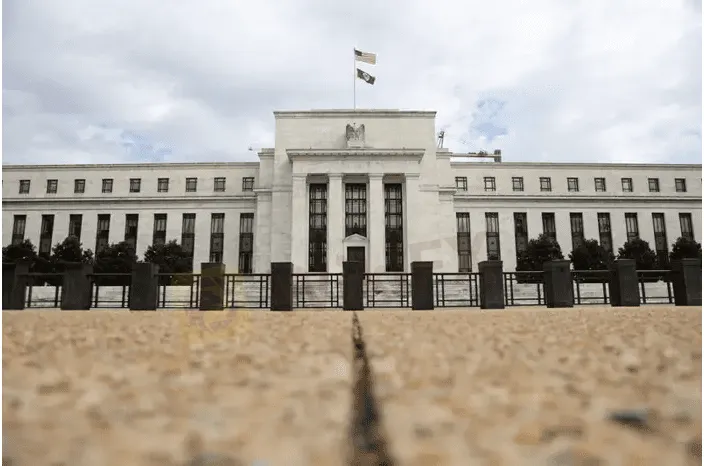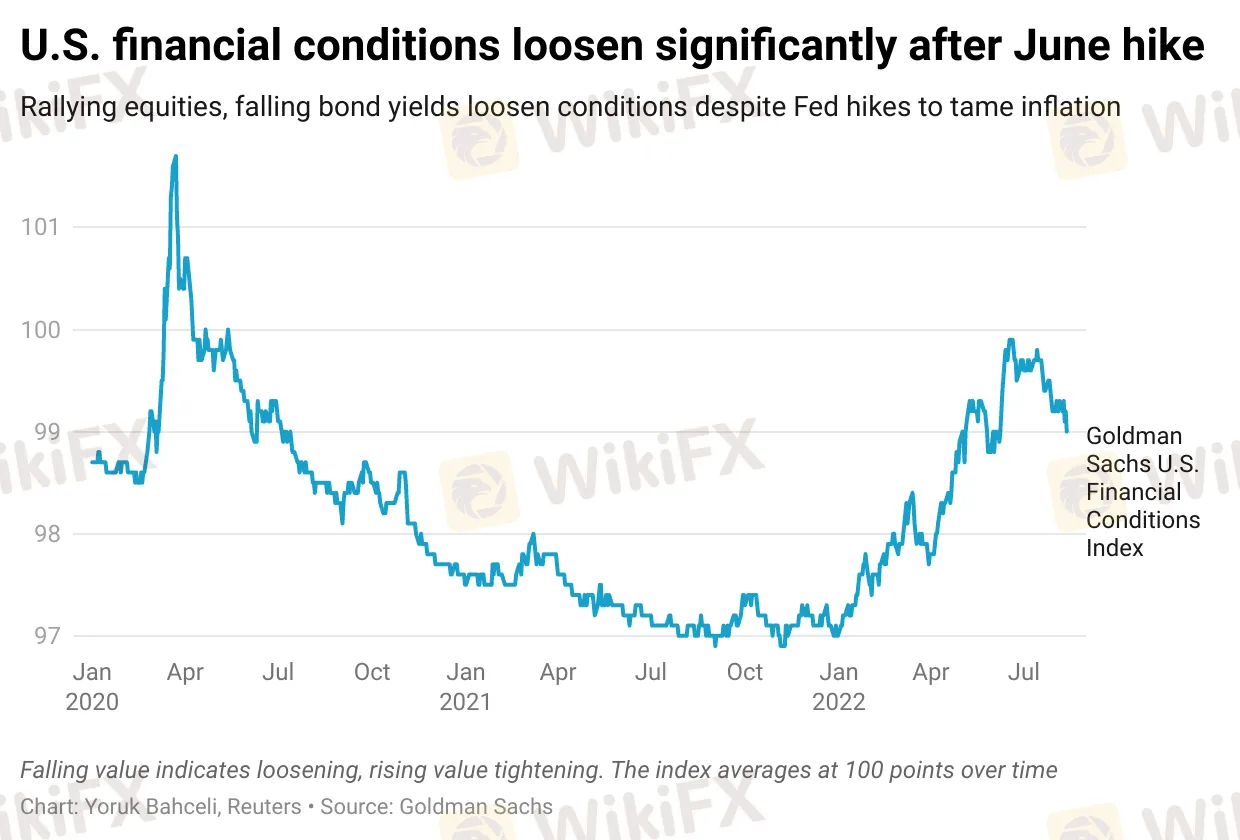简体中文
繁體中文
English
Pусский
日本語
ภาษาไทย
Tiếng Việt
Bahasa Indonesia
Español
हिन्दी
Filippiiniläinen
Français
Deutsch
Português
Türkçe
한국어
العربية
Analysis-Loosening financial conditions threaten central bank inflation fight
Abstract: The U.S. Federal Reserve is hiking interest rates at the most aggressive pace in a generation, but the financial conditions it needs to tighten to tame soaring inflation are heading in the wrong direction.

A rally in equities and falling government bond yields since the Feds June hike means financial conditions are actually loosening, despite the U.S. economy having been hit with a combined 150 basis points of rate hikes at that meeting and the next one.
Financial conditions reflect the availability of funding in an economy. They dictate spending, saving and investment plans of businesses and households, so central banks want them to tighten to help control inflation, which is now running far above their target levels.
A widely followed U.S. financial conditions index (FCI) compiled by Goldman Sachs, which factors in borrowing costs, equity levels and exchange rates, has loosened some 80 basis points (bps) since the Feds June meeting.
A similar index from the Chicago Federal Reserve, which tracks financial conditions independent of prevailing economic conditions, has turned negative, implying conditions are loose relative to what the current economic picture would usually suggest.
In the euro zone, conditions have also loosened by about 40 basis points, according to Goldman Sachs, and money markets have priced out most of the 2023 rate hikes they had previously expected.
“Back in June we thought that (U.S.) financial conditions were broadly where they should be to engineer the slowdown that you need to bring activity, wage growth and price inflation back to target,” said Daan Struyven, senior global economist at Goldman Sachs.
“Our best guess is that theyve eased a little too much.”

The change in conditions has been driven by recession fears, which have prompted markets to not only reduce how far they expect the Fed to hike, but also to price in rate cuts next year. This suggests investors think the Fed will be more concerned by a slowing economy rather than inflation next year.
Fed Chairman Jerome Powell‘s comments following the bank’s July rate hike were also interpreted by some investors as implying a “dovish pivot”.
Money markets now expect Fed hikes to stop at around 3.6% next March, compared with the 4%-plus expected before the June hike, followed by some 50 bps of cuts by the end of 2023.
Since the June hike, the S&P 500 has gained 13%, oil prices are down 22% and 10-year U.S. Treasury yields have fallen 70 bps. Credit markets have also rallied.
To be sure, financial conditions are still some 200 bps tighter than late 2021s record low, and stocks remain 10% down for 2022.
Goldman estimates a 100 bps tightening in its FCI will crimp economic growth by one percentage point in the coming year.
But the recent loosening is approaching what the bank terms an “FCI loop”, Struyven said.
“If you see very significant additional financial conditions easing that would probably not be sustainable because the outlook for activity, wage growth and inflation would look too hot.”
Unfinished job
That risk is already reflected in market gauges of long-term inflation expectations.
The 10-year U.S. breakeven rate has risen some 15 bps to 2.44% since early July. Euro zone expectations have risen too.
“That dovish interpretation was the reason why inflation expectations were driven up again. This just goes to show that the Fed still has an unfinished job ahead of itself,” said Patrick Saner, head of macro strategy at Swiss Re.
Data last week showing U.S. inflation unchanged in July instead of rising fuelled a further loosening in financial conditions.
But recent U.S. jobs and wage growth data point to increasingly tight labour markets.
Economists note the U.S. unemployment rate, at 3.5%, is far lower than the lowest level — 4.4% according to the Congressional Budget Office — it can reach without boosting inflation.

Disclaimer:
The views in this article only represent the author's personal views, and do not constitute investment advice on this platform. This platform does not guarantee the accuracy, completeness and timeliness of the information in the article, and will not be liable for any loss caused by the use of or reliance on the information in the article.
Read more

The Daily Habits of a Profitable Trader
Every professional trader follows a structured approach to ensure they are well-prepared, disciplined, and able to seize opportunities with confidence. Whether you are a seasoned investor or an aspiring trader, adhering to a robust daily checklist can significantly enhance your performance. Use this checklist to check if you are a qualified trader

The Impact of Interest Rate Decisions on the Forex Market
Interest rate changes determine currency attractiveness, influencing capital flows and exchange rate trends. Understanding this mechanism helps investors navigate the forex market effectively.

How a Housewife Lost RM288,235 in a Facebook Investment Scam
A 47-year-old housewife in Malaysia recently fell victim to an online investment scam, losing a substantial sum of RM288,235 after engaging with a fraudulent scheme advertised on Facebook.

A Trader’s Worst Mistake: Overlooking Broker Reviews Could Cost You Everything
In today’s digital age, reviews influence nearly every decision we make. When purchasing a smartphone, television, or home appliance, we pore over customer feedback and expert opinions to ensure we’re making the right choice. So why is it that, when it comes to choosing an online broker where real money and financial security are at stake many traders neglect the crucial step of reading reviews?
WikiFX Broker
Latest News
The Withdrawal Trap: How Scam Brokers Lure Victims into Paying More
FCA to Investors: Think Twice Before Trusting These Brokers
Trump\s tariffs: How could they affect the UK and your money
Trump gambles it all on global tariffs he\s wanted for decades
TradingView Brings Live Market Charts to Telegram Users with New Mini App
Trump tariffs: How will India navigate a world on the brink of a trade war?
Interactive Brokers Launches Forecast Contracts in Canada for Market Predictions
Authorities Alert: MAS Impersonation Scam Hits Singapore
Stocks fall again as Trump tariff jitters continue
IG Group Acquires Freetrade for £160M to Expand UK Investment Market
Currency Calculator







